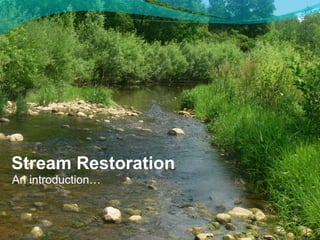
Stream Restoration 101
- 2. Evolution of “Restoration” Long history of working on and manipulating streams and rivers “Restoration”, “Rehabilitation”, “Stabilization” have all been used as justification to undertake restoration We continue to learn about, and evolve the science
- 3. So, what is “restoration”? To return to a healthy state To recover function As a stream environment changes, so do the expectations Each project is unique
- 4. The Order of Restoration In any stream restoration there is an order that should be followed. • Protect • Maintain • Restore • Enhance Consider passive vs. active restoration, such as valley wide protection, floodplain restoration before more intensive efforts such as channel restoration and habitat enhancement structures.
- 5. A Restoration Philosophy • Rivers, like most other natural systems, are highly dynamic and complex. The numerous processes and interactions that continually occur at varying scales are testaments to this natural complexity. • This complexity provides and sustains the various niches and habitats for biological organisms. • Recent advances in both physical and biological sciences, in addition to our growing understanding of these systems, has contributed to our ability to restore the natural dynamics and functions of rivers.
- 6. Restoration Objectives •Must meet socio-economic, ecological, physical, engineering, and regulatory goals of the project. • Result should be stable, not static. • Be appropriate for the physical setting (climate, land use, development restrictions, geology)
- 7. Restoration Tools & Approaches Approach – form based versus process based Awareness of viability What approach should you use? Need for understanding processes operating within your system
- 8. Design Approaches - Rational / Cognitive - Reference Reach - PFC (Proper Functioning Condition) - Deterministic / Analytical - Hydraulic Models - Permissible Tractive Force - Other (Specific Approaches) - Rosgen - Newbury - EPA (Natural Channel Design)
- 9. Channel Evolution As a channel deepens, it reaches a limit, a hard layer that is harder to erode. If it cant move downward, it will move to the side When if moves to the side, banks will erode and the channel becomes wider The channel will then re- establish itself
- 10. Channel Stability • Essentially a balance between flow regime and sediment loads • While stable, the channel may adjust its form, profile and position on its floodplain •When stable, the channel can accommodate changes in flow or sediment, as long as a threshold is not exceeded without altering its form.
- 11. When a channel becomes unstable • Depending upon nature and magnitude of the disturbance, a threshold in the stream may be exceeded, which will lead to substantial change and adjustment. • A channel will strive to achieve equilibrium but this can take decades to occur.
- 12. “Natural Channel Design” - Emphasizes geometry, plan, profile that will be stable under given flow/sediment regime with minimal armor/maintenanc e - Assumes most functions follow from geomorphic condition
- 13. Restoration –Considerations Scale of the site (bank treatment versus channel realignment) Design Process Data collection Analyses Design iterations Integration of disciplines/design components Implementation
- 14. Bank Erosion • Bank material more variable than bed material • Many factors involved in analysis – Flow properties – Bank composition – Climate – Subsurface conditions – Channel geometry – Mode of failure – Biology – Vegetation
- 15. Data Collection • Reach and cross- section scale • Used to determine & quantify channel processes • Necessary for all design approaches
- 16. Design Analyses • Hydrology • Sediment transport • Geomorphic relations • System dynamics
- 17. Hydrology Flow Duration Curves The flow duration curve is a plot that shows the percentage of time that flow in a stream is likely to equal or exceed some specified value of interest. Flow Frequency The probability a given streamflow will be exceeded in any given year. Related to Return-Interval (e.g. 100-Year Flood)
- 18. Why do we care about Hydrology? Properly developed statistical hydrology Allows for quantification of risk and success/failure Allows for the development of specific design criteria Provides tool for estimating bankfull discharges Critical link to understanding how physical conditions such as bank and bed shear stress and other sediment transport functions vary temporally.
- 19. Hydraulic Analysis Used to determine the impacts of flow on the channel, (how much and how fast), and other relations essential to restoration designs. Flow modeling • a simulation that represents the channel through geometry Sediment transport modeling •To understand the amount of sediment moving through the system •Can help to determine long term stability of the channel •Can be used to estimate sediment yield, and for comparative analysis between reaches
- 20. Design Discharge How do we select which flow to design for? • Low flow ~ habitat design • Bankfull Discharge ~ stable channel design • Flood Flows ~ regulatory compliance and flood hazard protection
- 21. Geomorphic Relations • Hydraulic Geometry • Regime Equations • Regional Curve Information • Meander Geometry • Gradient relationships
- 22. Examples of Natural Design Typical dynamic meander pattern
- 23. Options to move or enhance the stream Existing Section Restoration Section
- 24. Construction Implementation Erosion & Sediment Control •How we keep the process from impacting the valley Constructability •How can it be constructed? Details on how to build it •Where to access the work •What are the soils like •How are the flows in the channel dealt with
- 25. Access Considerations •Protect the channel •Minimize disturbance •Optimize materials delivery
- 27. Construction Techniques using hard materials
- 28. Construction Techniques using bioengineering
- 29. Channel Enhancements Fish habitat Habitat Creation using Habitat Creation using rock bioengineering
- 30. Thank-you